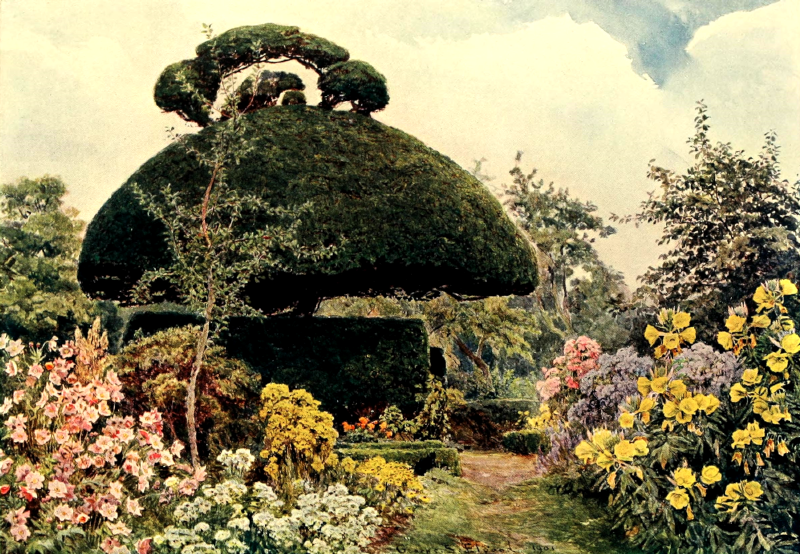| Web
and Book design,
Copyright, Kellscraft Studio 1999-2021 (Return to Web Text-ures) |
 (HOME)
|
|
YEW ARBOUR: LYDE It is
not in large gardens only that hardy flowers are to be seen in perfection.
Often the humblest wayside cottage may show such a picture of plant-beauty as
will put to shame the best that can be seen at the neighbouring squire's. And
where labouring folk have a liking for clipped yews, their natural good taste
and ingenuity often turns them into better forms than are seen among the
examples of more pretentious topiary work. The
cottager has the undoubted advantage that, as his tree is usually an isolated
one, he can see by its natural way of growth the kind of figure it suggests for
his clipping; whereas the gardener in the large place usually has to follow a
fixed design. So it is that one may see in a cottage garden such a handsome
example as the yew in the picture. The
lower part of the tree is nearly square in plan, with a niche cut out for a
narrow seat. There is space enough between the top of this and the underside of
the great mushroom-shaped canopy, to allow the upper surface of the square base
to be green and healthy. The great rounded top proudly carries its handsome
crest, that is already a good ornament and will improve year by year. The
garden is raised above the road and only separated from it by a wall which is
low on the garden side and deeper to the road. It passes by the side of the
yew, so that the occupier of the seat commands a view of the road and all that
goes along it, and can exchange greetings and gossip with those who pass by. The
cottagers of the neighbourhood — it is in Herefordshire, about four miles from
Hereford — have a special fancy for these clipped yews; many examples may be
met with in an afternoon's walk. Not very far from this is a capital peacock
excellently rendered in conventional fashion. It stands well above a high
pedestal, one side of which is hollowed out for a little seat. One
may well understand what a pride and pleasure and amusing interest these clipped
trees are to the cottage folk; how after each year's clipping they would
discuss and criticise the result and note the progress of the growth towards
the hoped-for form. A pile of cheeses is a favourite pattern, sometimes on a
square base, with the topmost ornament cut into a spire or even a crown. The
English peasant has a love for ornament that always strives to find some kind
of expression. In many parts the thatcher makes a kind of basket ornament on
the top of his rick; and the pattern of crossed laths, pegged down with the
hazel "spars" that finishes the thatched cottage roof near the eaves,
is of true artistic value. The carter loves to dress his horses for town or
market, and a fine team, with worsted ribbons in mane and headstall, and
quantities of gleaming highly-polished brasses, is indeed a pleasant sight upon
the country high road. Now,
alas! when cheap rubbish, misnamed ornamental, floods village shops and finds
its way into the cottages, the cottager's taste, which was always true and good
as long as it depended on its own prompting and instinct, and could only deal
with the simplest materials, is rapidly becoming bewildered and debased. All
the more, therefore, let us value and cherish these ornaments of the older
traditions; the bright little gardens and the much-prized clipped yew. A
usual feature of these cottage yews is that the seat is for one person alone.
The labourer sits in his little retreat enjoying his evening pipe after his
day's work, while the wife puts the children to bed and gets the supper.
Probably he has been harvesting all day, and his strong frame is tired, with
that feeling of almost pleasant fatigue that comes to a wholesome body after a
good day's work well done; and when the hardly-earned rest is thoroughly
enjoyed. So he sits quite quiet, with one eye on the possible interests of his
outer world, the road, and the other on the beauty of his flower-border. And
what a pretty double border it is, with its grand mass of pink Japan Anemone
and well-flowered clump of Goldilocks (one of the few yellow-bloomed Michaelmas
Daisies), looking at its near relation in purple over the way. A graceful little Plum-tree shoots up through the flowers; its long free shoots of tender green seem to laugh at the rigid surface of the clipped yew beyond. Don't be too confident about your freedom, little Plum; it is more than likely that you will be severely pruned next winter. But you need not mind, for if you lose one kind of beauty, you will gain others; the pure white bloom of spring-time, and the autumn burden of purple fruit; and be both handsome and useful, like your neighbour the old yew.  THE YEW ARBOUR, LYDE From the picture in the possession of Mr. George E. B. Wrey |